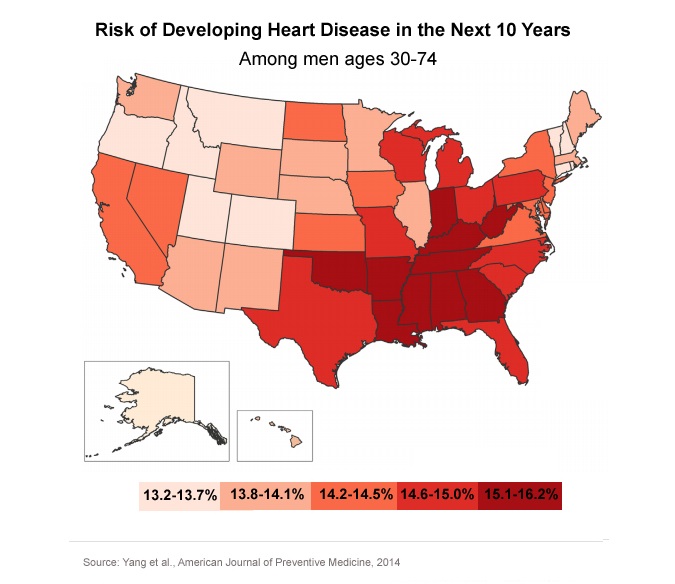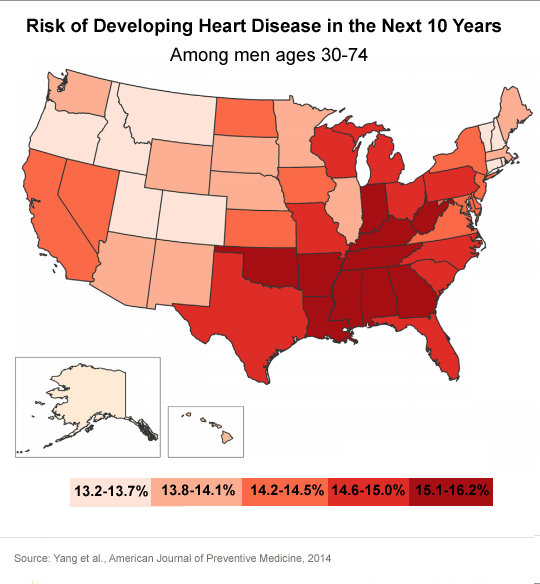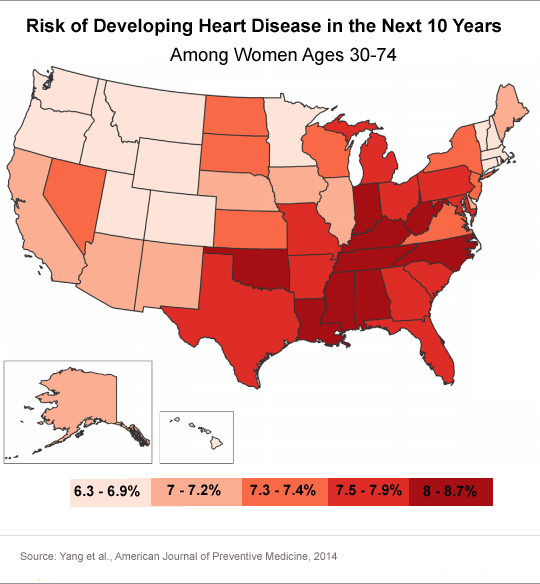Where Is Heart Disease Risk the Highest and Lowest? (Maps)

People's risk of developing heart disease depends on biological factors, such as their age and gender, but it also tends to vary based on where they live. Now, a new study has estimated the risk of heart disease for people in each U.S. state.
Researchers at the Centers for Disease Control and Prevention looked at medical data of nearly 300,000 people ages 30 to 74, to estimate people's risk of developing heart disease over the next 10 years. The risk was calculated by looking at a number of risk factors, including high blood pressure and cholesterol, smoking habits, obesity and low consumption of fruits and vegetables.
The results showed a remarkable variation across states. People with a higher heart disease risk tended to live in the Southeastern states, and people with a lower risk tended to live in Northwestern states. [See a map of the U.S. with heart disease risk for each state]
Nationally, the researchers' calculations predicted that 14.6 percent of men and 7.5 percent of women will develop heart disease over the next 10 years.
For men, the risk ranged from a low of 13.2 percent in Utah to a high of 16.2 percent in Louisiana. For women, Minnesota had the lowest risk, with 6.3 percent, and the risk was highest in Mississippi, with 8.7 percent, according to the study, published Nov. 9 in the American Journal of Preventive Medicine.
The risk was higher among blacks than among people of other racial and ethnic groups, according to the study. Moreover, people with less than a high school education and those with household incomes below $35,000 had a higher risk than other groups of developing heart disease over the next 10 years.
Heart disease and its related conditions are the leading cause of death in the United States. Nearly 800,000 people die each year from heart disease and stroke, and at least 200,000 of these deaths are preventable, according to the CDC. More than half of preventable heart disease and stroke deaths occur in people younger than 65.
Get the world’s most fascinating discoveries delivered straight to your inbox.
The new findings could help inform the government's public health initiatives, such as the Healthy People 2020 and the Million Hearts initiatives, which are working to reduce deaths from heart disease and stroke, the researchers said. Knowing how people's risks break down by state can help public health researchers focus more efforts on states where the risk is highest, the researchers said.
Public health officials hope to reduce heart disease rates by promoting healthy lifestyles and addressing medical conditions that are major risk factors for heart disease. For example, high blood pressure, or hypertension, is one condition that can lead to heart disease and stroke, and it affects about 1 in 3 U.S. adults. A recent study found that Minnesotans reported the lowest rate of hypertension (21 percent), whereas the rate was highest (36 percent) in Mississippi. Only half of the Americans who have hypertension have their condition under control by taking medication, according to the CDC.
Another major risk factor for heart disease and stroke is diabetes, a condition that has become more common and is predicted to affect one-third of Americans by 2050 if current trends continue. In 2012, 29.1 million Americans, or 9.3 percent of the population, had diabetes, compared with 8.3 percent of the population in 2010, according to the American Diabetes Association. Maintaining a healthy diet, losing excess weight and exercising can markedly lower people's risk of developing diabetes, studies have shown.
Email Bahar Gholipour. Follow Live Science @livescience, Facebook & Google+. Originally published on Live Science.





